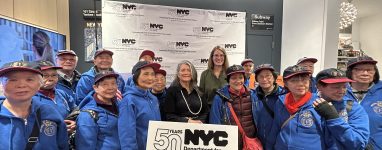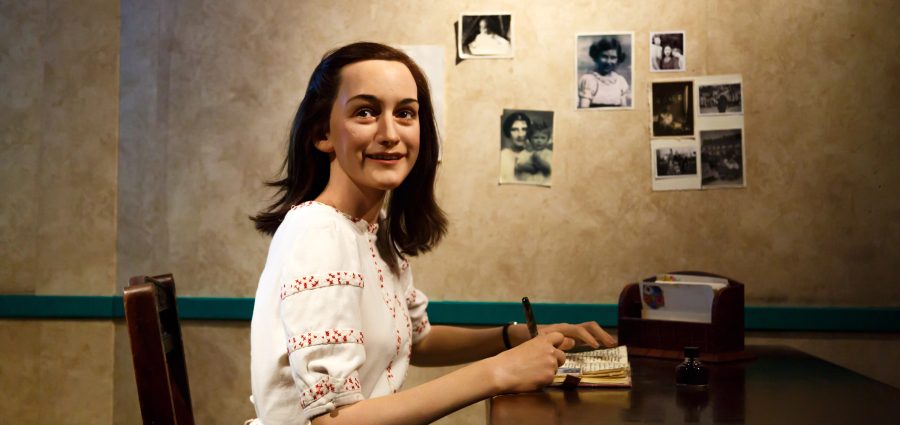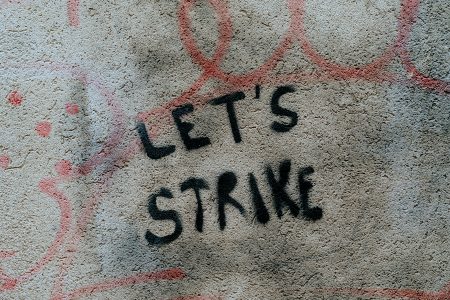Anne Frank The Exhibition is launching an innovative curriculum to confront antisemitism across the United States, in response to extraordinary interest from middle and high schools since its debut on International Holocaust Remembrance Day 2025. This new initiative powerfully responds to teachers’ urgent calls for classroom resources that address the full spectrum of antisemitism, from its historical roots to current manifestations. This bold educational commitment solidifies the Anne Frank House’s role as a global leader in education, dedicated to combating antisemitism, racism, and discrimination and empowering the next generation to actively challenge hatred and prejudice.
Anne Frank the Exhibition will distribute an additional 20,000 free copies of Anne Frank: The Diary of a Young Girl to students in New York City and Long Island public schools this year, building on the 10,000 diaries distributed over the summer. This initiative further extends access to Anne Frank’s powerful story, reaching thousands more students beyond those who have already engaged with the exhibition this year. This strengthened collaboration with NYC Public Schools—with the distribution of 20,000 copies of Anne Frank: The Diary of a Young Girl—is made possible thanks to the generosity and leadership of UJA-Federation of New York, Heckscher Foundation for Children, and Einstein Astrof Foundation, with additional support from Melik-Baschkopf Foundation and the Slome Family.
Distribution of free copies of Anne Frank’s diary is a collaborative initiative with the NYC Public Schools Office of Library Services and the Department of Social Studies/Civics, coordinated directly with school librarians and social studies teachers. Guided by both educator interest and targeted outreach, this effort prioritizes schools with limited Holocaust education resources and ensures the diaries are integrated into classrooms with tailored curriculum, teacher training, and ongoing support, making Anne Frank’s story a vibrant part of student learning and civic dialogue.
With support of the Einstein Astrof Foundation, Anne Frank The Exhibition is also expanding their distribution of Anne Frank: The Diary of a Young Girl to students from Long Island who visit the exhibition, in addition to increasing free access to the exhibition for students from Title 1 public schools on Long Island.
This news follows the announcement of the final exhibition extension through February 1, 2026, and complimentary enhanced access days for families, educators, librarians, and select groups (eligibility information below) on November 4th (Election Day) and November 11th (Veterans Day).
The curriculum, produced in partnership with the University of South Carolina’s Anne Frank Center to support classrooms nationwide, confronts antisemitism with urgency and clarity, spanning more than two thousand years of hateful myths, persecution, pogroms, and the Holocaust, and shining a light on antisemitic ideologies in today’s world. This educational tool provides students with a powerful, personal lens to understand antisemitism by tracing it through the life of Otto Frank, whom tens of thousands of students have come to know through the exhibition. While anchored in historical context, the curriculum also prompts students to examine contemporary issues, highlighting how antisemitism reemerges today through social media, violence, denial, and other evolving forms.
“In response to the urgent needs voiced by teachers and students who have experienced Anne Frank The Exhibition, the Anne Frank House has developed a new antisemitism curriculum. Driven by an obligation to meet educators and learners where they are, this curriculum provides practical tools for confronting antisemitism, past and present, and helps foster a personal sense of responsibility in standing against hate. To ensure meaningful classroom impact, we are offering training sessions with our expert education team, empowering educators to guide students in building a more just and compassionate world,” said Ronald Leopold, Executive Director of the Anne Frank House.
Educators can access the curriculum, specifically designed for secondary students, through the Anne Frank The Exhibition website. Teachers are invited to register for free sessions with education experts from the University of South Carolina for personalized guidance on delivering these lesson plans, tailored to student needs, classroom rigor, and readiness to address antisemitism.
The curriculum aligns with New York State’s K–12 social studies framework, as well as the College, Career, and Civic Life (C3) standards adopted by 38 additional states. By integrating historical context with practical tools, this resource empowers students to recognize and confront antisemitism, preparing them for active, informed civic engagement.
As noted when the exhibition was extended last month, New York State Education Commissioner Betty A. Rosa said, “Anne Frank The Exhibition provides a profound educational experience that connects the lessons of history to the challenges and responsibilities of today. It provides students with a meaningful opportunity to explore the realities of antisemitism and intolerance while equipping educators with resources to thoughtfully integrate these lessons into their instruction. This exhibition not only honors the memory of Anne Frank and her family but also strengthens our shared responsibility to ensure that future generations learn the importance of empathy, tolerance, and standing against hate in all its forms.
In that same announcement, Merryl H. Tisch, Chairman of the Board of Trustees of the State University of New York and former Chancellor of the New York State Board of Regents, said, “Anne Frank’s story is a timeless beacon for education that goes beyond history, teaching us the essential values of resilience, empathy, and standing against antisemitism and hatred. It is our responsibility as leaders and educators to ensure that students of all ages learn these lessons deeply, so that Anne’s legacy inspires a more inclusive and compassionate future.”
“Providing our students with the tools to recognize and stand against hate is one of our most urgent responsibilities as educators,” said New York City Public Schools Chancellor Melissa Aviles-Ramos. “We commend and thank the Anne Frank House for Anne Frank: The Exhibition, which powerfully connects students to history and serves as a critical reminder of the importance of fighting antisemitism. By placing 20,000 books in the hands of young New Yorkers, the Anne Frank House is shaping a more compassionate and empathetic society.”
“It has never been more important to give young people the tools they need to rise above barriers, reach their full potential, and contribute meaningfully to society,” said Peter Sloane, CEO of the Heckscher Foundation for Children. “Placing Anne Frank: The Diary of a Young Girl into the hands of thousands of New York City public school students is an act of empowerment. When young people are equipped to read, think critically, and empathize deeply, they become the citizens who will lead us toward a stronger, more just, and united future.”
“Books have the power to open minds, spark empathy, and inspire action,” said Jackie Einstein Astrof, President of the Einstein Astrof Foundation. “By placing Anne Frank: The Diary of a Young Girl directly into the hands of New York students, we are giving young people both the tools and the stories they need to understand the dangers of prejudice and the value of compassion. Literacy is more than a skill, it is a pathway to stronger, more resilient communities. In the fight against antisemitism, ensuring that every student encounters Anne’s voice is an investment in a future defined by understanding and respect.”
“Anne Frank’s diary gives voice to the hopes and fears of a young girl facing unimaginable hatred — and that voice still speaks powerfully to young people today,” said Eric S. Goldstein, CEO, UJA-Federation of New York. “By helping to put this book directly into the hands of students, we’re giving them the opportunity to connect personally with Anne’s story, reflect on the consequences of hatred, and understand the possibility of resilience and the human spirit. Particularly now, at a time of sharply rising hatred targeting the Jewish community, our hope is that young readers will be inspired to stand up to hate, to find courage in the face of adversity, and to believe in the power of their own voices.”
With the launch of a curriculum designed for educators across the United States, the Anne Frank House reaffirms its mission: to keep Anne’s story and voice alive and to educate new generations to stand against antisemitism, racism, and all forms of discrimination.
Special Access Days with complimentary admission:
General admission tickets are available every day the exhibition is open, and enhanced complimentary admission will be offered to select visitors on the following dates:
November 4 (Election Day): All-day access for families, Hometown Heroes, educators, and librarians.
November 11 (Veterans Day): All-day access for families, Hometown Heroes, educators, and librarians.
Official ID and email are required for police officers, firefighters, first responders, medical professionals, military personnel, educators, and librarians for free admission on special access days. Tickets for special access days are available with day-of on-site registration. Follow Anne Frank The Exhibition on Instagram, Tik Tok, and Facebook for more details and regular updates.
About Anne Frank The Exhibition
Anne Frank The Exhibition is the first time in history that the Anne Frank House presents a pioneering experience outside of Amsterdam to immerse visitors in a full-scale recreation of the Annex rooms, fully furnished, where Anne Frank, her parents and sister, and four other Jews spent two years hiding to evade Nazi capture.
Moving through the exhibition, visitors can immerse themselves in the context that shaped Anne’s life—from her early years in Frankfurt through the rise of the Nazi regime and the family’s phased move to Amsterdam across 1933 and 1934, where Anne lived for ten years until her 1944 arrest and deportation to Westerbork, a large transit camp in the Netherlands, then to Auschwitz-Birkenau, a concentration camp and killing center in Nazi-occupied Poland, and eventually to her death at Bergen-Belsen concentration camp in Germany when she was 15 years old.
Four exhibition galleries immerse visitors in place and history through video, sound, photography, and animation; and more than 100 original collection items from the Anne Frank House in Amsterdam. Anne Frank The Exhibition provides an opportunity to learn about Anne Frank not as a victim but through the multifaceted lens of her life—as a girl, a writer, and a symbol of resilience and strength. This is a story inspired by one of the most translated books in the world.
The New York City exhibition occupies over 7,500 square feet of gallery space in the heart of Union Square. This marks the first time dozens of artifacts can be seen in the United States—many have never been seen in public.
Artifacts in the exhibition include:
- Anne Frank’s first photo album (1929-1942);
- Anne Frank’s typed and handwritten invitation to her friend for a film screening in her home (by 1942, anti-Jewish measures prohibited Jews from attending the cinema); and
- Handwritten verses by Anne Frank in her friends’ poetry albums.
Advising the Anne Frank House on the New York City exhibition is Michael S. Glickman, CEO of jMUSE. Dr. Doyle Stevick, Executive Director of The Anne Frank Center at the University of South Carolina, the Anne Frank House’s official U.S. partner, is the educational advisor.
The exhibition is made possible through the generosity of many philanthropic foundations and individuals, whose partnership has ensured the exhibition is available to students and educators throughout the United States, as well as throughout the local New York City metro region.
Anne Frank The Exhibition is a limited engagement, now extended through February 2026.
Anne Frank House gratefully acknowledges the following benefactors who have contributed to the exhibition:
The exhibition is made possible by Leon Levy Foundation, with leadership support by David Berg Foundation, Rebecca and Jared Cohen, Stacey and Eric Mindich, Merryl and James Tisch, The Koum Family Foundation, UJA-Federation of New York, and corporate partner Bank of America. Educational patrons to the exhibition include Gray Foundation and The Fuhrman Family Foundation, with additional support by The Barbra Streisand Foundation.
Major support has been provided by Debbie and Mark Attanasio, Tanya and Ryan Baker, Einstein Astrof Foundation, Elyssa and William Friedland, Jesselson Foundation, Allison and Warren Kanders, Pershing Square Philanthropies, Sara Naison-Tarajano, The Krupp Foundation, Katharine M. and Leo S. Ullman, and Anonymous, with sponsorship support by GRoW @ Annenberg, Rita J. & Stanley H. Kaplan Family Foundation, Karyn Kornfeld & Steven Kobre, The Claire Friedlander Family Foundation, and Zegar Family Foundation. Pro bono legal services provided by Wachtell, Lipton, Rosen & Katz.
General Information
Tickets are available at AnneFrankExhibit.org. The exhibition is designed for children (ages 10 and older) and adults. All general admission tickets include the exhibition audio guide. Visitors should plan to spend approximately one hour at the exhibition. The last entry is one hour before closing.
Individual tickets
- Timed entry tickets, Monday through Friday: $24 (17 and under, $18);
- Timed entry tickets, Sunday: $31 (17 and under, $24);
- Flex tickets, Monday through Friday: $38;
- Flex tickets, Sunday: $54.
Family tickets (2 adults + 2 children under 17 years):
- Timed entry tickets, Monday through Friday: $74 (additional 17 and under ticket, $18);
- Timed entry tickets, Sunday: $98 (additional 17 and under ticket, $24).
Group sales (adults)
- $300 per group of 10, timed entry, Monday through Friday;
- $400 per group of 10, timed entry, Sunday.
Hours:
- Sunday through Thursday: 9:30 a.m. to 7:30 p.m.
- Friday: 9:30 a.m. to 3:30 p.m.
- Saturday: closed
Address:
Center for Jewish History
15 W. 16th Street
New York, NY 10011
Follow Anne Frank The Exhibition on Instagram, Tik Tok, and Facebook.
About the Annex
In July 1942, Anne Frank (13), her parents, Otto and Edith Frank, and her sister, Margot Frank (16), went into hiding in the annex at the back of her father’s company. The Van Pels family (Hermann, Auguste, and their 15-year-old son, Peter) followed the next week. Four months later, they were joined by Fritz Pfeffer. All of them were Jews daring to escape certain death at the hands of the Nazis amid the German occupation of the Netherlands during World War II. Unable to go to school, largely cut off from the rest of the world, and trapped in close quarters with others while a war raged outside, Anne poured herself into her diary. The people in hiding in the Annex were discovered in 1944, and Anne and the others were arrested and sent to the Auschwitz-Birkenau concentration and extermination camp. Anne and her sister Margot were then sent to the Bergen-Belsen concentration camp, where they both died of typhus in February 1945. Anne was 15. Margot was 18 or 19. Otto Frank was the only person from the Annex to survive the Holocaust.
About the Diary
Anne Frank: The Diary of a Young Girl, more commonly known as The Diary of Anne Frank, is one of the most translated books in the world. Transformed multiple times for stage and screen, the published book’s source is the personal diary that Anne Frank kept in multiple notebooks during the two-year period of hiding with her family in rooms located in the back house of her father’s company in Amsterdam. Soon after Anne and the others were arrested in 1944, Miep Gies, one of the people who risked their lives to help them in hiding, returned to the Annex and found their belongings ransacked. Miep was relieved to find Anne’s diary pages, knowing how important her writings were to her, and saved them for her return. Otto was the only person from the Annex to survive the Holocaust. When Miep first gave him his daughter’s diary, he could not bring himself to read it. Soon, he did and he could not stop, sharing it with relatives and friends who encouraged him to publish what they considered “an important human document.” Upon its publication, Otto Frank wrote: “How proud Anne would have been if she had lived to see this. After all, on March 29, 1944, she wrote: ‘Imagine how interesting it would be if I published a novel about Secret Annex.'”
About the Anne Frank House
The Anne Frank House was established in 1957 in cooperation with Otto Frank, Anne Frank’s father, as an independent nonprofit organization entrusted with the preservation of the Annex where Anne Frank and her family went into hiding in 1942 during the Second World War. The Annex is where Anne wrote her diary, and where she and her family hid from the Nazis during the occupation of the Netherlands until being discovered and arrested by police officers in 1944. Following her transport to the Auschwitz-Birkenau concentration and extermination camp, Anne and her sister Margot were sent to the Bergen-Belsen concentration camp, where they died in 1945. For nearly seven decades, the Anne Frank House has served as a place of memory and a place of learning. Committed to bringing Anne’s life story to world audiences, the Anne Frank House has emerged as a primary resource for teaching and learning about the Holocaust. Through Anne’s legacy the Anne Frank House empowers people of all ages—and especially young people—to reflect on the dangers of antisemitism, racism, and discrimination and the importance of freedom, equal rights, and democracy.
About the Center for Jewish History
The Center for Jewish History illuminates the Jewish past for audiences today and preserves it for the future. Home to the world’s largest Jewish archive outside Israel, it is a dynamic space for learning and public engagement. Opened in 2000, the Center is the collaborative home of five partner organizations (the American Jewish Historical Society, American Sephardi Federation, Leo Baeck Institute, Yeshiva University Museum, and YIVO Institute for Jewish Research) whose collections comprise over 7 miles of archival documents, 500,000 volumes of books, 12 million digital items, and thousands of artworks, objects, textiles, and recordings. The Center opens these vast archives to the public and activates the stories that they hold through exhibits, fellowships, genealogy programs, and an active calendar of events – making it a hub for Jewish culture and heritage. To learn more about the Center and its public programs, please visit cjh.org.
Featured image credit: DepositPhotos.com








